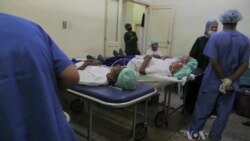RANGOON, BURMA —
Burma has one of the highest rates of blindness in the world, afflicting an estimated 8.1 percent of the population in rural areas. More than half of the cases are due to cataracts, which cloud the eye lens over time. Now, a team of Nepalese cataract experts have been allowed into the country to perform more than a 1,000 free operations in what is hoped to be the first of many such ventures.
Here at the Yangon Eye Hospital, an amazing transformation has recently occurred.
In a matter of weeks, a joint medical team from Nepal and Burma will have completed more than 1200 free cataract operations - a treatable eye disease that leads to impaired vision - and sometimes blindness.
The numbers are daunting, but for the hospital director, Dr. Tin Win, a big part of the problem is lack of knowledge.
“The tradition in Myanmar [Burma] is they are very apprehensive to undergo surgery so they don’t want to be operated. They are afraid. They accept a cataract as an aging process. It’s true. It’s an aging process but this process can be overcome by surgery,” said Tin Win.
The massive endeavor is being led by Nepalese Dr. Sanduk Ruit, who helped develop the low-cost, high-volume, surgical technique that replaces the eye lens. Dr. Ruit's team from the Tilganga Eye Centre has carried out operations in locations such as North Korea, Ethiopia and Indonesia.
Now, the doctor is eager to help spread his expertise and training in a country where basic medical assistance is still too costly for most.
“It's very important that we take this service to the community level at different parts of Myanmar and I hope the Ministry of Health will give us non-obstructive passage,” said Ruit.
The surgery can be a life altering moment for many of these patients, who have had difficulty seeing for years.
For Daw Tin Hla, simple tasks like pouring a glass of water and cooking would now, once again, be easier. “I am really happy because I have got my sight again. They told me to walk slowly but I didn’t. I am eager to walk very quickly. After the operation I feel free.”
While the first group of patients readjusts to their improved vision, the team hopes to train community doctors and paramedics to carry on the work.
Here at the Yangon Eye Hospital, an amazing transformation has recently occurred.
In a matter of weeks, a joint medical team from Nepal and Burma will have completed more than 1200 free cataract operations - a treatable eye disease that leads to impaired vision - and sometimes blindness.
The numbers are daunting, but for the hospital director, Dr. Tin Win, a big part of the problem is lack of knowledge.
“The tradition in Myanmar [Burma] is they are very apprehensive to undergo surgery so they don’t want to be operated. They are afraid. They accept a cataract as an aging process. It’s true. It’s an aging process but this process can be overcome by surgery,” said Tin Win.
The massive endeavor is being led by Nepalese Dr. Sanduk Ruit, who helped develop the low-cost, high-volume, surgical technique that replaces the eye lens. Dr. Ruit's team from the Tilganga Eye Centre has carried out operations in locations such as North Korea, Ethiopia and Indonesia.
Now, the doctor is eager to help spread his expertise and training in a country where basic medical assistance is still too costly for most.
“It's very important that we take this service to the community level at different parts of Myanmar and I hope the Ministry of Health will give us non-obstructive passage,” said Ruit.
The surgery can be a life altering moment for many of these patients, who have had difficulty seeing for years.
For Daw Tin Hla, simple tasks like pouring a glass of water and cooking would now, once again, be easier. “I am really happy because I have got my sight again. They told me to walk slowly but I didn’t. I am eager to walk very quickly. After the operation I feel free.”
While the first group of patients readjusts to their improved vision, the team hopes to train community doctors and paramedics to carry on the work.










